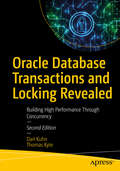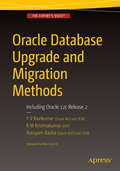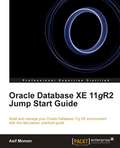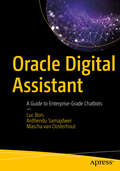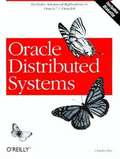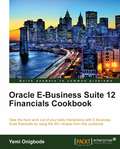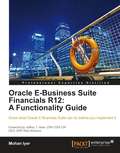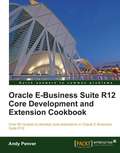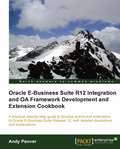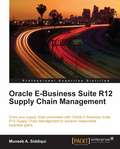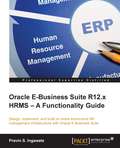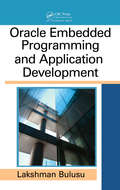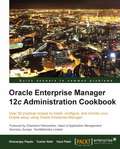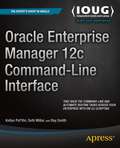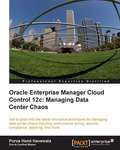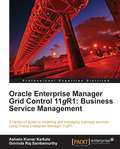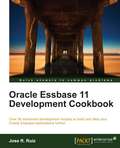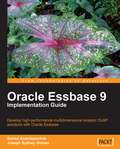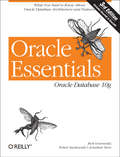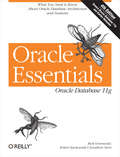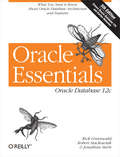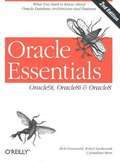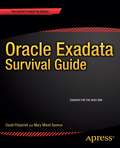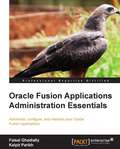- Table View
- List View
Oracle Database Transactions and Locking Revealed: Building High Performance Through Concurrency
by Darl Kuhn Thomas KyteAccess much-needed information for building scalable, high-concurrency applications and deploying them against the Oracle Database. This new edition is updated to be current with Oracle Database 19. It includes a new chapter with troubleshooting recipes to help you quickly diagnose and resolve locking problems that are urgent and block production.Good transaction design is an important facet of highly-concurrent applications that are run by hundreds, even thousands, of users who are executing transactions at the same time. Transaction design, in turn, relies on a good understanding of how the database engine manages the locking of resources to prevent access conflicts and data loss that might otherwise result from concurrent access to data in the database. This book provides a solid and accurate explanation of how locking and concurrency are dealt with by Oracle Database. You will learn how the Oracle Database architecture accommodates user transactions, and how you can write code to mesh with the way in which Oracle Database is designed to operate.Oracle Database Transactions and Locking Revealed covers in detail the various lock types, and also different locking schemes such as pessimistic and optimistic locking. Then you will learn about transaction isolation and multi-version concurrency, and how the various lock types support Oracle Database’s transactional features. You will learn tips for transaction design, as well as some bad practices and habits to avoid. Coverage is also given to redo and undo, and their role in concurrency. The book is loaded with insightful code examples that drive home each concept. This is an important book that anyone developing highly-concurrent applications will want to have handy on their shelf.What You Will LearnAvoid application lockups due to conflicts over accessing the same resourceUnderstand how Oracle prevents one application from overwriting another’s modificationsCreate transaction designs that mesh with how Oracle Database is designedBuild high-throughput applications supporting thousands of concurrent usersDesign applications to take full advantage of Oracle’s powerful database engineGain a fundamental knowledge of Oracle’s transaction and locking architectureDevelop techniques to quickly diagnose and resolve common locking issuesWho This Book Is ForOracle developers and database administrators faced with troubleshooting and solving deadlocks, locking contention, and similar problems that are encountered in high-concurrency environments; and application developers wanting to design their applications to excel at multi-user concurrency by taking full advantage of Oracle Database’s multi-versioning and concurrency support
Oracle Database Upgrade and Migration Methods
by Nassyam Basha Y V Ravikumar K M KrishnakumarLearn all of the available upgrade and migration methods in detail to move to Oracle Database version 12c. You will become familiar with database upgrade best practices to complete the upgrade in an effective manner and understand the Oracle Database 12c patching process. So it's time to upgrade Oracle Database to version 12c and you need to choose the appropriate method while considering issues such as downtime. This book explains all of the available upgrade and migration methods so you can choose the one that suits your environment. You will be aware of the practical issues and proactive measures to take to upgrade successfully and reduce unexpected issues. With every release of Oracle Database there are new features and fixes to bugs identified in previous versions. As each release becomes obsolete, existing databases need to be upgraded. Oracle Database Upgrade and Migration Methods explains each method along with its strategy, requirements, steps, and known issues that have been seen so far. This book also compares the methods to help you choose the proper method according to your constraints. Also included in this book: Pre-requisite patches and pre-upgrade steps Patching to perform changes at the binary and database level to apply bug fixes What You Will Learn: Understand the need and importance of database upgrading and migration Be aware of the challenges associated with database upgrade decision making Compare all upgrade/migration methods Become familiar with database upgrade best practices and recommendations Understand database upgrade concepts in high availability and multi-tenant environments Understand Oracle 12c patching concepts Know the database downgrade steps in case the upgraded database isn't compatible with the environment Know the features and benefits to the organizations when it moves from the old database version to the latest database version Who This Book Is For: Core database administrators, solution architects, business consultants, and database architects
Oracle Database XE 11gR2 Jump Start Guide
by Asif MomenThis book discusses concepts and tasks through real-world examples. The author uses simple language, screenshots, and a step-by-step approach to get you started with Oracle Database administration. If you are a student or beginner who is learning to administer Oracle Database, then this book is for you. This book is designed to cover the problems that novice DBAs particularly struggle with, so no prior knowledge of Oracle database administration is expected.
Oracle Digital Assistant: A Guide to Enterprise-Grade Chatbots
by Luc Bors Ardhendu Samajdwer Mascha van OosterhoutUse this book as an on-ramp to the development of enterprise-grade chatbots and digital assistants. It is based on real-life experience and explains everything you need to know to start building your own digital assistant (DA) using Oracle technologies. You will become familiar with the concepts involved in DA development from both a user experience and technical point of view. You will learn to create DAs using Oracle technologies, including the Oracle Digital Assistant Cloud. In the first part of the book, you will learn the basic principles of the digital assistant (AKA Chatbot) technology. You will be guided through the steps involved in designing a DA, including how to make sure that the user receives a satisfying experience when using the assistant. In the second part of the book, you will learn how to implement the digital assistant that was designed in the first part. You will begin with a basic implementation, later enhancing that implementation with agents, multi-language support, and webviews. The final part of the book adds a deep dive into custom component development with an example around sentiment analysis and speech.What You Will LearnDesign digital assistants to meet business requirementsImplement a great user experience for your digital assistantsTranslate digital assistant design into real implementationsBuild multi-language support into your assistantsEnhance digital assistants with webviewsCreate custom components to extend feature setsWho This Book Is ForDesigners and developers who want to implement digital assistants using Oracle technologies and the cloud platform. This book is ideal for readers new to creating digital assistants, and covers aspects of design, including user experience design, before moving into the technical implementation. Readers experienced in creating digital assistants on other platforms will find the book useful for making the transition to Oracle technologies and the Oracle Digital Assistant Cloud.
Oracle Distributed Systems
by Charles DyeThis book describes how you can use multiple databases and both Oracle8 and Oracle7 distributed system features to best advantage. It covers design, configuration of SQL*Net/Net8, security, and Oracle's distributed options (advanced replication, snapshots, multi-master replication, updateable snapshots, procedural replication, and conflict resolution). Includes a complete API reference for built-in packages and a diskette with many helpful scripts and utilities.
Oracle E-Business Suite 12 Financials Cookbook
by Yemi OnigbodeThere are many ways of configuring and using Oracle EBS R12 Financials. This cookbook demonstrates how to use EBS R12 Financials in a way that will enable you to understand the core functionalities of the main financials modules. Each recipe is presented as part of a scenario-based chapter that details typical business scenarios. This book is for EBS Financials specialists who want a broader understanding of particular areas of the financials modules. Businesses can use this book to identify key functionalities of the financial modules, and very quickly demonstrate a pilot to obtain the core requirements. If you are a Business Analyst, Functional Consultant, Technical Consultant, Project Sponsor, Project Manager, Project Team Member, System Accountant or Solution Designer, Testing Team Member, Training Team Member or Support Team Member, then this book is for you. This book assumes that you have basic navigation skills and you understand the key Oracle EBS terminology, novice EBS professionals will also gain from the expert content of this book.
Oracle E-Business Suite Financials R12: A Functionality Guide
by Mohan IyerThis is a step-by-step functional guide to get you started easily with Oracle EBS Financials. If you are an Oracle E-Business Suite Financial consultant or an administrator looking to get a quick review on the capabilities of Oracle E-Business Suite and improve the use of the systems functionality, then this is the best guide for you. This book assumes that you have a fundamental knowledge of EBS Suite.
Oracle E-Business Suite R12 Core Development and Extension Cookbook
by Andy PenverThis is a practical, hands-on book providing in depth tutorials on each topic. It is full of step by step examples of the key points for each subject to give a core understanding. The examples are designed to be worked through, and start right from scratch. Each topic will cover the development, configuration and testing of working examples. The book provides clear illustrations and tips each step of the way. It also comes with fully tested, complete, working code - if ever you get stuck. Each chapter introduces the topic and what you need to do to get ready to start the exercises. It will tell you what tools you need to use and when to use them. This book is written for individuals who want to learn how to develop extensions in Oracle E-Business suite. If you are involved in development or supporting an e-business suite implementation you should find this book very useful. The book is detailed so minimal technical expertise is required. It is suitable for beginners who have little experience or developers who may want to use the book to brush up on their skills.
Oracle E-Business Suite R12 Integration and OA Framework Development and Extension Cookbook
by Andy PenverThis is a practical, hands-on book providing in depth tutorials in each topic. It is full of step by step examples of the key points for each subject to give a core understanding. The examples are designed to be worked through and start right from scratch. Each topic will cover the development, configuration and testing of working examples. The book provides clear illustrations and tips each step of the way. It also comes with fully tested, complete, working code if ever you get stuck. Each chapter introduces the topic and what you need to do to get ready to start the exercises. It will tell you what tools you need to use and when to use them.This book is written for those who want to learn how to develop extensions in Oracle E-Business Suite. If you are involved in developing or supporting an e-business suite implementation you should find this book very useful. The book is detailed and therefore minimal technical expertise is required. It is suitable for those new to E-Business Suite or those wanting to broaden their knowledge who may want to use the book to brush up on their skills.
Oracle E-Business Suite R12 Supply Chain Management
by Muneeb A. SiddiquiThis is a practical tutorial written in a clear and easy-to-understand style taking the reader through relevant, real-world examples that can be put into practice immediately. It contains detailed instructions and plenty of screenshots to make it easier for readers to understand Oracle E-Business Suite and work on it effectively. This book is aimed at all those who are working on Oracle E-Business Suite, such as administrators and consultants. End users who want to explore Oracle supply chain management will also find the book extremely useful. No prior knowledge of Oracle EBS SCM is required to get going with this book.
Oracle E-Business Suite R12.x HRMS – A Functionality Guide
by Pravin S. IngawaleIf you are a developer or functional consultant of Oracle's E-Business Suite HRMS who wants to learn the logical flow of the processes involved in human resources and where Oracle HCM fits into the overall enterprise structure, then this book is for you. Basic knowledge of Oracle's E-Business Suite components is essential.
Oracle Embedded Programming and Application Development
by Lakshman BulusuFocusing on tried and true best practice techniques in cross-technology based Oracle embedded programming, this book provides authoritative guidance for improving your code compilation and execution. Geared towards IT professionals developing Oracle-based Web-enabled applications in PL/SQL, Java, C, C++, .NET, Perl, and PHP, it covers application d
Oracle Enterprise Manager 12c Administration Cookbook
by Dhananjay Papde Vipul Patel Tushar NathAs a Packt Cookbook, you can expect this book to be full of useful and practical recipes to common and important tasks faced by professional database administrators. This book is for Oracle Database, Middleware, System, and Infrastructure Administrators. A basic understanding of Oracle Enterprise Manager is needed, as well as being comfortable using command line environments.
Oracle Enterprise Manager 12c Command-Line Interface
by Ray Smith Kellyn Pot'Vin Seth MillerOracle Enterprise Manager 12c Command-Line Interface shows how to use Enterprise Manager's powerful scripting language to automate your database administration work and save time by scripting routine tasks, and then executing those scripts across collections of databases and instances in your environment. This book is chock full of ready-made scripting examples contributed by the authors and leading members of the community. For example, you'll find scripts and examples of commands to: Remove an Enterprise Manager agent and its related targets Quickly create administrator accounts that are fully-configured with pre-expired passwords and all needed roles Invoke batch files to execute sequences of related commands with consistency against multiple targets Batch create large groups of user logins with a single command and more! The Enterprise Manager Command Line Interface (EM CLI) is the administrator's key to unlocking the power of Enterprise Manager 12c (EM12c) with scalability, repeatability, and confidence. In previous versions, most administrators ventured into the command-line interface only with the assistance of Oracle Support. But now there are many features in EM12c that are accessible only from the command-line. This is far from a disadvantage! Enterprise Manager is now a powerful tool for automation in the hands of a skilled database administrator. Enterprise Manager scripting offers potential for all administrators who manage Oracle's enterprise-level products in their environment. You can automate from the smallest, single-instance configuration all the way up to a broadly distributed enterprise-level rollout having database instances strewn across broad geographical distributions. The power of the EM CLI returns the administrator to the golden age, where the entire environment, from database to application to infrastructure, can often be managed from this powerful command line tool secured by the robust Enterprise Manager framework. Brings a golden-age of automation to Oracle Database administrators Provides ready-made scripts contributed by leading members of the community Covers advanced techniques involving Jython and Python What you'll learn Learn the architecture that makes EM CLI so powerful. Secure the EM CLI framework in your own environment for ease of management. Write scripts to execute tasks consistently across individual targets, multiple targets, or even monitored groups. Schedule your scripts; detect and manage exceptions when they fail. Build a library of scripts to be shared among your administrative team and/or share them globally via the web. Who this book is for Oracle Enterprise Manager 12c Command-Line Interface is written for database administrators and others who are using Enterprise Manager 12c. The book is especially aimed at those wanting to take advantage of EM CLI's scripting engine to automate tasks and leverage their time across dozens, hundreds, or even thousands of database and other instances being managed. Table of Contents 1. Architecture 2. Installation and Security Framework 3. Terminology and Basics 4. Working from Command Line 5. Automating through Shell Scripts 6. Writing Native EM12c Scripts 7. The Software Library and Extensibility Exchange 8. Scripting Examples and Cookbook
Oracle Enterprise Manager Cloud Control 12c: Managing Data Center Chaos
by Porus Homi HavewalaThis book is a practical step-by-step tutorial with screenshots for carrying out tasks showing you how to manage and administer your data center with Oracle Enterprise Manager. It is packed with best practices and tips that will help you benefit from the author's extensive experience of working with Oracle Enterprise Manager since at least a decade, and combined with his 25+ years IT industry experience. If you have used Enterprise Manager before and are aware of its capabilities, this will be a good primer for learning the brand new capabilities of the new version. For people who want to be introduced to Enterprise Manager for the first time, this will be a whole new world - drawn from the author's professional experiences of many years in the IT industry, written in easy-to-understand English.
Oracle Enterprise Manager Grid Control 11g R1: Business Service Management
by Govinda Raj Sambamurthy Ashwin Kumar KarkalaA practical, focused tutorial, this book will show you how to use Oracle Enterprise Manager Grid Control 11g R1 to deliver Business Service Management (BSM). Best practices cutting across multiple product verticals like Database, Middleware, Packaged Applications, and Custom Business Services are also covered. If you are a System Administrator or Application Administrator who is responsible for Business Service Management (BSM) using Oracle Enterprise Manager Grid Control 11g R1, then this book is for you. You need basic knowledge of Middleware/Application Servers, Business Service Management, and Oracle Enterprise Manager Grid Control.
Oracle Essbase 11 Development Cookbook
by Jose R. RuizThis cookbook is full of immediately useable recipes showing you the advanced development techniques when building Essbase Applications and how to take these applications further. This cookbook offers practical, task-based, and immediately usable recipes covering a wide range of advanced development techniques to build Essbase Applications and take them further. In addition to its cookbook style, which ensures the solutions are presented in a clear step-by-step manner, its explanations go into great detail, which makes it good learning material for everyone who has experience in Essbase and wants to improve. The book is designed in such a way that you can either read it chapter by chapter or refer to recipes that you want in no particular order. If you are an experienced Essbase developer, Essbase Database Designer or Database Administrator, then this book is for you. This book assumes that you have good knowledge of Oracle Essbase.
Oracle Essbase 9 Implementation Guide
by Joseph Sydney Gomez Sarma AnantapantulaThis book uses a practical step-by-step approach with the next chapter always building on the knowledge foundation created by the previous chapter. Understanding and really grasping the multidimensional concept is difficult enough without a lot of confusing jargon thrown in. This book speaks to the reader in plain English with plenty of easy-to-follow examples. You will create, build, and maintain data for a fictional automobile company. This book is primarily for the IT professional who has a good understanding of IT principles and processes but is a multidimensional OLAP novice. Experienced OLAP professionals will also gain insight from this book. Simply put, if you are in the IT field and wish to gain a functional level of knowledge in the world of Oracle Essbase, whether it be for a developer role or a PM or BA role, this is the book you need.
Oracle Essentials, 4th Edition
by Rick Greenwald Robert Stackowiak Jonathan SternOracle is an enormous system, with myriad technologies, options, and releases. Most users-even experienced developers and database administrators-find it difficult to get a handle on the full scope of the Oracle database. And, as each new Oracle version is released, users find themselves under increasing pressure to learn about a whole range of new technologies. The latest challenge is Oracle Database 11g. This book distills an enormous amount of information about Oracle into a compact, easy-to-read volume filled with focused text, illustrations, and helpful hints. It contains chapters on: * Oracle products, options, data structures, and overall architecture for Oracle Database 11g, as well as earlier releases (Oracle Database 10g, Oracle9i, and Oracle8i) * Installing, running, managing, monitoring, networking, and tuning Oracle, including Enterprise Manager (EM) and Oracle's self-tuning and management capabilities; and using Oracle security, auditing, and compliance (a new chapter in this edition) * Multiuser concurrency, data warehouses, distributed databases, online transaction processing (OLTP), high availability, and hardware architectures (e.g., SMP, clusters, NUMA, and grid computing) * Features beyond the Oracle database: Oracle Application Express, Fusion Middleware (including Oracle Application Server), and database SOA support as a Web services provider The latest Oracle Database 11g features: query result set caching, Automatic Memory Management, the Real Application Testing, Advanced Compression, Total Recall, and Active Data Guard Option Options, changes to the OLAP Option (transparently accessed and managed as materialized views), the Flashback transaction command, transparent data encryption, the Support Workbench (and diagnosability infrastructure), and partitioning enhancements (including interval and new composite types) For new Oracle users, DBAs, developers, and managers, Oracle Essentials provides an invaluable, all-in-one introduction to the full range of Oracle features and technologies, including the just-released Oracle Database 11g features. But even if you already have a library full of Oracle documentation, you'll find that this compact book is the one you turn to, again and again, as your one-stop, truly essential reference.
Oracle Essentials: Oracle Database 10g
by Rick Greenwald Robert Stackowiak Jonathan SternAn enormous system comprising myriad technologies, options, and releases, Oracle's complexities have spawned numerous areas of specialization. For each area of specialization there are equally specialized how-to books and manuals. O'Reilly's Oracle Essentials claims a unique place among these books. Rather than focusing on one area, the book explains the foundational concepts of the Oracle technology and the core technical and business aspects of using it.The new edition of this classic book, Oracle Essentials, 3rd Edition: Oracle Database 10g, distills a vast amount of knowledge into an easy-to-read volume covering every aspect of the Oracle database. Readers of all levels will learn about Oracle's features and technologies, including the product line, architecture, data structures, networking, concurrency, tuning, and much more.Featuring focused text, abundant illustrations, and helpful hints, the new edition offers a valuable overview of Oracle's Database 10g--the industry's first database to support grid computing. Recent releases such as Oracle 9i and 8i are also covered. The book contains chapters on:Oracle products, options, and overall architecture for Oracle 10g and prior recent releasesInstalling and running Oracle: how to configure, start up, and shut down the database, and various networking issuesOracle data structures, datatypes, and ways of extending datatypes, with an introduction to Oracle objects (e.g., tables, views, indexes)Managing Oracle: security, the Oracle Enterprise Manager, fragmentation and reorganization, and backup and recoveryOracle performance: characteristics of disk, memory, and CPU tuningMulti-user concurrency, online transaction processing (OLTP), and high availabilityHardware architectures (e.g., SMP, MPP, NUMA) and their impact on OracleData warehousing and distributed databasesNetwork deployment: using Oracle as an Internet computing platform and for grid computingWhat's new in Oracle 10g: a summary of the database changes described in the bookOracle Essentials, 3rd Edition: Oracle Database 10g was written for anyone whose job involves managing or building systems using Oracle DBMS technology or working with staff that uses Oracle technology. This book is the perfect all-in-one source for understanding the complexities and capabilities of Oracle.
Oracle Essentials: Oracle Database 11g
by Rick Greenwald Robert Stackowiak Jonathan SternOracle is an enormous system, with myriad technologies, options, and releases. Most users--even experienced developers and database administrators--find it difficult to get a handle on the full scope of the Oracle database. And, as each new Oracle version is released, users find themselves under increasing pressure to learn about a whole range of new technologies. The latest challenge is Oracle Database 11g.This book distills an enormous amount of information about Oracle into a compact, easy-to-read volume filled with focused text, illustrations, and helpful hints. It contains chapters on:Oracle products, options, data structures, and overall architecture for Oracle Database 11g, as well as earlier releases (Oracle Database 10g, Oracle9i, and Oracle8i)Installing, running, managing, monitoring, networking, and tuning Oracle, including Enterprise Manager (EM) and Oracle's self-tuning and management capabilities; and using Oracle security, auditing, and compliance (a new chapter in this edition)Multiuser concurrency, data warehouses, distributed databases, online transaction processing (OLTP), high availability, and hardware architectures (e.g., SMP, clusters, NUMA, and grid computing)Features beyond the Oracle database: Oracle Application Express, Fusion Middleware (including Oracle Application Server), and database SOA support as a Web services providerThe latest Oracle Database 11g features: query result set caching, Automatic Memory Management, the Real Application Testing, Advanced Compression, Total Recall, and Active Data Guard Option Options, changes to the OLAP Option (transparently accessed and managed as materialized views), the Flashback transaction command, transparent data encryption, the Support Workbench (and diagnosability infrastructure), and partitioning enhancements (including interval and new composite types)For new Oracle users, DBAs, developers, and managers, Oracle Essentials provides an invaluable, all-in-one introduction to the full range of Oracle features and technologies, including the just-released Oracle Database 11g features. But even if you already have a library full of Oracle documentation, you'll find that this compact book is the one you turn to, again and again, as your one-stop, truly essential reference."Oracle Essentials gives a clear explanation of the key database concepts and architecture underlying the Oracle database. It's a great reference for anyone doing development or management of Oracle databases."--Andrew Mendelsohn, Senior Vice President, Database Server Technologies, Oracle Corporation
Oracle Essentials: Oracle Database 12c
by Rick Greenwald Robert Stackowiak Jonathan SternWritten by Oracle insiders, this indispensable guide distills an enormous amount of information about the Oracle Database into one compact volume. Ideal for novice and experienced DBAs, developers, managers, and users, Oracle Essentials walks you through technologies and features in Oracle’s product line, including its architecture, data structures, networking, concurrency, and tuning.Complete with illustrations and helpful hints, this fifth edition provides a valuable one-stop overview of Oracle Database 12c, including an introduction to Oracle and cloud computing. Oracle Essentials provides the conceptual background you need to understand how Oracle truly works.Topics include:A complete overview of Oracle databases and data stores, and Fusion Middleware products and featuresCore concepts and structures in Oracle’s architecture, including pluggable databasesOracle objects and the various datatypes Oracle supportsSystem and database management, including Oracle Enterprise Manager 12cSecurity options, basic auditing capabilities, and options for meeting compliance needsPerformance characteristics of disk, memory, and CPU tuningBasic principles of multiuser concurrencyOracle’s online transaction processing (OLTP)Data warehouses, Big Data, and Oracle’s business intelligence toolsBackup and recovery, and high availability and failover solutions
Oracle Essentials: Oracle9i, Oracle8i & Oracle8, Second Edition
by Rick Greenwald Robert Stackowiak Jonathan SternUpdated for Oracle's latest release, Oracle9i, Oracle Essentials is a concise and readable technical introduction to Oracle features and technologies, including the Oracle architecture, data structures, configuration, networking, tuning, and data warehousing. It introduces such major Oracle9i features as Real Application clusters, flashback queries, clickstream intelligence, Oracle Database and Web Cache, XML integration, the Oracle9i Application Server, Oracle9i Portal, and much more.
Oracle Exadata Survival Guide
by David Fitzjarrell Mary Mikell SpenceOracle Exadata Survival Guide is a hands-on guide for busy Oracle database administrators who are migrating their skill sets to Oracle's Exadata database appliance. The book covers the concepts behind Exadata, and the available configurations for features such as smart scans, storage indexes, Smart Flash Cache, hybrid columnar compression, and more. You'll learn about performance metrics and execution plans, and how to optimize SQL running in Oracle's powerful, new environment. The authors also cover migration from other servers. Oracle Exadata is fast becoming the standard for large installations such as those running data warehouse, business intelligence, and large-scale OLTP systems. Exadata is like no other platform, and is new ground even for experienced Oracle database administrators. The Oracle Exadata Survival Guide helps you navigate the ins and outs of this new platform, de-mystifying this amazing appliance and its exceptional performance. The book takes a highly practical approach, not diving too deeply into the details, but giving you just the right depth of information to quickly transfer your skills to Oracle's important new platform. Helps transfer your skills to the platform of the future Covers the important ground without going too deep Takes a practical and hands-on approach to everyday tasks
Oracle Fusion Applications Administration Essentials
by Kalpit Parikh Faisal GhadiallyThis is a practical guide to Oracle Fusion Applications, which illustrates concepts using handson examples. It is comprehensive and covers all the essentials of Oracle Fusion Applications administration.This book is ideal for application and database administrators who are looking to get an understanding of administering Oracle Fusion Applications. Familiarity with Oracle Database Administration and an operational Oracle Fusion Applications environment would be useful, but is not required.
